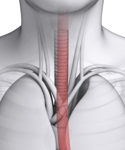For a study, researchers sought to determine if Pediatric Eosinophilic Esophagitis (EoE) Symptom Score version 2 (PEESSv2.0) ratings could tell the difference between kids with EoE and kids with non-EoE esophageal dysfunction who had their first esophagogastroduodenoscopy (EGD). A prospective cohort study of pediatric participants was done as part of the research. The study included children aged 1 to 18 who had their first EGD for esophageal dysfunction. At the time of the EGD, demographics, clinical history, child self-report, and parent-proxy report PEESSv2.0 symptom scores were obtained. EoE was defined as more than 15 eosinophils/high powered field (hpf) found in any level of the esophagus, based on esophageal biopsies. Non-EoE was classified as eosinophils/hpf less than 15. From 2015 to 2018, 71 youngsters were studied [59% (42/71) were males; mean age 9.2 years; range 1–17 years]. About 58% (41/71) of the participants satisfied the EoE criteria, while 42% (30/71) were classified as non-EoE. The median PEESSv2.0 total scores of non-EoE children and their parents were higher/worse than those of EoE children and their parents [47.0 vs 28.0 (P=0.001) and 40.5 vs 26.5 (P=0.012), respectively]. When compared to EoE children, non-EoE children had higher median GERD [9.0 vs 4.0 (P=0.003)], nausea/vomiting [9.0 vs 4.0 (P=0.003)], and pain [11.0 vs 6.0 (P=0.001) subdomain scores. PEESSv2.0 dysphagia subdomain scores (child and parent-proxy) were similar in EoE and non-EoE groups [22.0 vs 15.0 (P=0.184) and 18.5 vs 17.4 (P=0.330), respectively]. The non-EoE group’s total PEESSv2.0 scores were lower than the EoE. PEESSv2.0 was validated for monitoring EoE therapy; however, it does not distinguish children with EoE esophageal dysfunction from children with non-EoE esophageal dysfunction at the time of diagnostic EGD.
Source:journals.lww.com/jpgn/Abstract/2022/03000/Eosinophilic_Esophagitis_Symptom_Scores_Are_High.16.aspx


